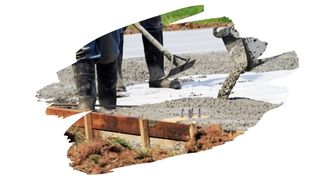Concrete is probably one of the most common ways to affix a wooden post into the ground.
But, why use concrete at all? Especially, as concrete can rot away any wooden post that it comes into prolonged contact with.
Well, in this post, you will learn how pressure treatments help wood to stave off rot and decay. You’ll also discover why even pressure treated wood can rot if placed directly into wet cement.
And keep reading to find out the best (and most rot-resistant) way to set pressure treated wooden posts into concrete.

This post may contain affiliate links to products that we receive a commission for (at no additional cost to you). Learn more here.
What Does Pressure Treatment Really Do To Wood?
Well, pressure treatment involves infusing wood with water-soluble chemical preservatives.
Those preservatives are fantastic at preventing wood rot bacteria from growing in lumber. So much so, that pressure treating wood can double the longevity of timber.
And you’ll know if your fence post has been pressure treated by simply checking it for a stamp. In the USA/UK/Canada, pressure treated wood is typically stamped with PT (Pressure Treated) or GC (Ground Contact).
But Do You Have to Use Pressure Treated Wood For A Fence Post?
Not always. Especially if it is made from a very rot-resistant timber. For example, untreated White Oak can last a good while — even without wood preservatives.
Related Post: Is White Oak Good For Making Durable Outdoor Furniture?
But, even very durable rot-resistant timbers will decay away faster than need be, if they have not been treated.
In the case of treated White Oak, this hardwood can last up to two decades in the great outdoors. But, if Oak is left untreated, it can decay away in as little as 8 years.
OK. Well, I’m Setting Up a Fence Post In Concrete? Can Pressure Treated Wood Be Set Directly Into Concrete?
You could, but not if you want the fence post to last. That’s because the parts of the fence that have direct contact with concrete, will rot fairly quickly.
And the reason for this is very simple; moisture.
Wet concrete has a lot of moisture in it. And that wooden fence post will wick up moisture wherever it touches concrete.
Plus, even after concrete has dried, this hard substance is incredibly porous. And as a porous material, it has plenty of tiny holes in it for ground moisture to collect in. So this in turn, also leads to the fence post soaking up ground moisture as well.
Now, this is all due to something called Concrete Carbonation. Concrete carbonation is the culprit behind why gluing wood directly to concrete can be tricky.
Concrete contains calcium hydroxide which reacts with carbon dioxide in the air, causing carbonation to occur. This carbonation process creates fizzy bubble-like reactions, similar to the bubbles in soda.
Carbonation is one reason concrete shifts and moves over time due to factors like soil settlement, weather changes, and the carbonation process itself. That’s why using the proper adhesive is crucial for attaching wood to concrete. The adhesive needs to stretch and flex as the concrete moves.
An elastomeric coating designed for moisture resistance is ideal for gluing wood to concrete. The elastic nature of the adhesive allows it to flex along with the concrete as it undergoes natural movement over time. We dive more into the details on selecting the best concrete-to-wood adhesive here: What’s The Best Way To Go About Gluing Plywood To Concrete?
Related Post: Should You Use Nails Or Screws On A Wooden Fence? (Solved!)
But Doesn’t Pressure Treated Wood Protect Wood From Rotting?
It does, but it is only a treatment, so it’ll work up to a point. It is not a waterproofing sealant, and it won’t prevent wood from absorbing water.
So, pressure treated wood will still need a sealant to prevent it from succumbing to weathering and decay.
But, having said that, there some exceptions to the general rule of not using unsealed pressure treated wood outdoors.
Unsealed wooden fence posts can survive outside if constructed from naturally durable and rot-resistant woods like White Oak, Western Red Cedar, or Douglas Fir. These woods have natural properties that enable them to withstand outdoor exposure even without a protective sealant coating.
However, applying an end grain sealer is still recommended for even these types of weather-resistant lumbers.
The end grain is the most vulnerable part of the wood that soaks up moisture from the soil. And a quality end grain sealer prevents this absorption, further protecting the wood’s structure.
For more tips on how to seal and maintain untreated landscape timbers and wooden fence posts for maximum longevity outdoors, check out this helpful guide: How To Keep Your Landscape Timbers From Ever Warping Again
Related Post: How To Dry Pressure Treated Wood (Quickly And Without Warping)
So Will Pressure Treated Wood Always Rot In Concrete? Is That Why You Should Never Set Wood In Wet Concrete?
Pretty much. If you do nothing to shield wood from concrete, then that lumber will become saturated with moisture. And that leads to damp wood fibers — which is the perfect environment for wood rot bacteria to thrive.
And even the chemicals used in pressure treatments cannot stave off rot, if wood is left perpetually damp.
What’s more, setting a wooden post right down into wet concrete, can harm the integrity of concrete itself. That’s because the fence post can soak up moisture from concrete, before cement has had time to set properly.
Can’t You Simply Wrap A Post In Plastic Before You Go Pouring In Concrete?
On the surface of it, this seems like a good idea. That plastic should be enough to shield wood from concrete, right?
Well, this is only a good idea in theory. But, in practice, it won’t help prevent wood rot. In fact, it will help encourage it.
You see, that plastic will do a decent job at capturing ground moisture — like a bucket placed out in the rain.
So, short-term, plastic wrap will prevent concrete moisture from getting into your fence post. However, long term, it will gather up the ground moisture. And your wooden post will soak up an excessive amount of ground moisture later on as a result.
So What Do You Put Between Concrete And Wood?
If you want to protect pressure treated posts, you need to ‘seal’ over that concrete with a moisture-resistant adhesive.
It should be moisture-resistant enough to prevent concrete from seeping water into the fence post. And, at the same time, it’ll double as a glue that steadfastly holds the fence post in place.
So, you should use something called an ‘Elastomeric Coating’. These coatings can act as a waterproofing barrier between concrete and wood.
Wait A Minute…What Are Elastomeric Coatings Exactly?
Elastomeric coatings are basically flexible waterproof protective barriers. They are coated onto walls, subflooring, and roofing. And they can be used both indoors and outside.
But, what makes these specific coatings extra special, is their elasticity. They can be stretched and elongated to over twice their length, and not snap. And they’ll even return back to their original length afterward.
And this ability to stretch and adapt to stress, is the reason why this coating is primarily used on concrete floors. That, and the fact that it can prevent concrete from cracking due to carbonation.
What Do You Mean By Concrete Carbonation? This occurs whenever carbon dioxide, (in the air around us), reacts with the calcium hydroxide inside wet concrete. When that happens, carbonation (which is a gassy reaction that’s similar to the fizziness you find in sodas) can occur.
And Which Elastomeric Coating Do You Recommend?
You should only use an elastomeric coating that also doubles as an adhesive. And one of the best one’s on the market comes from Bostik.
Bostik’s BEST urethane adhesive is a solvent-based substance that’s used primarily as a glue for flooring. Basically, this is the stuff you would use to affix hardwood planks to porous concrete.
However, Bostik’s adhesive can be used to affix all manner of solid wood into position. And while it’s typically used for subflooring, it can work equally well in keeping a post in place as well.
Now, what makes this urethane adhesive extra special is that it acts like a moisture-resistant film over concrete. And this film will prevent the ground water inside concrete, from getting into the wooden post.
What’s more, Bostik’s Best contains their patented Blockade Antimicrobial Protection. And this works to prevent mold or mildew from growing on this urethane adhesive. So, it can be used outside.
If you want to learn more about Bostik’s Best, you can check them out over on their website here.
To Wrap Up, Here Are The 3 Key Takeaways From This Post…
- 1). Pressure treated wood contains wood preservatives that help wood to stave off decay.
- 2). But even pressure treated wood will rot away sooner rather than later, if it has prolonged direct contact with concrete.
- 3). So, you should place an elastomeric adhesive coating between concrete and fence posts. The elastomeric coating will prevent wood from absorbing moisture from concrete’s porous surface.
References:
Fallon, Chanel, and Graham J. McShane. “Impact damage protection mechanisms for elastomer-coated concrete.” International Journal of Protective Structures 12.3 (2021): 377-395.



